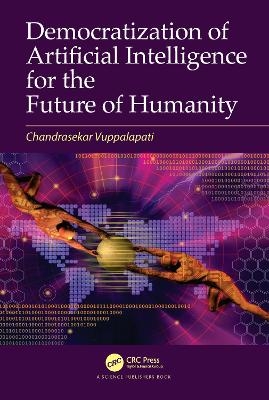
Democratization of Artificial Intelligence for the Future of Humanity
CRC Press (Verlag)
978-0-367-52412-8 (ISBN)
Artificial intelligence (AI) stands out as a transformational technology of the digital age. Its practical applications are growing very rapidly. One of the chief reasons AI applications are attaining prominence, is in its design to learn continuously, from real-world use and experience, and its capability to improve its performance. It is no wonder that the applications of AI span from complex high-technology equipment manufacturing to personalized exclusive recommendations to end-users. Many deployments of AI software, given its continuous learning need, require computation platforms that are resource intense, and have sustained connectivity and perpetual power through central electrical grid.
In order to harvest the benefits of AI revolution to all of humanity, traditional AI software development paradigms must be upgraded to function effectively in environments that have resource constraints, small form factor computational devices with limited power, devices with intermittent or no connectivity and/or powered by non-perpetual source or battery power.
The aim this book is to prepare current and future software engineering teams with the skills and tools to fully utilize AI capabilities in resource-constrained devices. The book introduces essential AI concepts from the perspectives of full-scale software development with emphasis on creating niche Blue Ocean small form factored computational environment products.
Chandrasekar Vuppalapati graduated from San Jose State University Masters Program, specializing Software Engineering, and completed his Master of Business Administration from Santa Clara University, Santa Clara, California, USA. He is a Software IT Executive and Entrepreneur with diverse experience in Software Technologies, Enterprise Software Architectures, Cloud Computing, Data Analytics, Internet of Things (IoT), and Software Product & Program Management. Chandra has held engineering architectures and product leadership roles at Microsoft, GE Healthcare, Cisco Systems, St. Jude Medical, and Lucent Technologies, a Bell Laboratories Company. He teaches Software Engineering, Large Scale Analytics, Data Science, Mobile Technologies, Cloud Technologies, and Web & Data Mining for Masters program in San Jose State University. Chandra has also held market research, strategy and technology architecture advisory roles in Cisco Systems, Lam Research and performed Principal Investigator role for Valley School of Nursing where he connected Nursing Educators & Students with Virtual Reality technologies. He has authored several international conference papers and published book on Building Enterprise IoT Applications. Chandra has served as Chair in numerous technology and advanced computing conferences such as: IEEE Oxford, UK, IEEE Big Data Services 2017, San Francisco USA, Future of Information and Communication Conference 2018, Singapore and Intelligent Human Systems Integration (IHSI) 2020, Modena, Italy.
SECTION I - INTRODUCTION TO ARTIFICIAL INTELLIGENCE AND FRAMEWORKS
Introduction
What is AI?
AI Epoch’s: Waves of Compute
AI Hype Cycle – Current and Emerging Technologies
AI - End-To-End (E2E) Process – Turning Data into Actionable Insights
Microsoft Azure - AI E2E Platform
AI Development Operations (DevOps) Loop for Data Science
AI –Performance and Computational Notations
AI for Greater Good – Solving Humanity and Societal Challenges
References
Standard Processes and Frameworks
Digital Transformation
Digital Feedback Loop
Insights Value Chain
The CRISP-DM Process
Building Blocks of AI - Major Components of AI
AI Reference Architectures
References
SECTION II - DATA SOURCES AND ENGINEERING TOOLS
Data – Call for Democratization
Call for Action
The Last Mile - Constrained Compute Devices AND "AI Chasm"
References
Machine Learning Frameworks and Device Engineering
Machine Learning Device Deployments
xRC Modeling: Model Accuracy-Connectivity-Hardware (MCH) Framework
Circular Buffers
AI Democratization – "Crossing the Chasm"
References
Device Software and Hardware Engineering Tools
Software Engineering Tools
Hardware and Engineering Tools
Libraries
References
SECTION III - MODEL DEVELOPMENT AND DEPLOYMENT
Supervised Models
Decision Trees
XGBoost
Random Forrest
Naïve Bayesian
Linear Regression
Kalman Filter
References
Unsupervised Models
Hierarchical Clustering
K-Means Clustering
References
SECTION IV - DEMOCRATIZATION AND FUTURE OF AI
National Strategies
National Technology Strategies for Serving People
The United Nations AI Technology Strategy
The role of the UN
AI in the Hands of People
References
Future
Democratization of Artificial Intelligence for the Future of Humanity
Dedication
Acknowledgement
Preface
Appendix
Index
| Erscheinungsdatum | 19.01.2021 |
|---|---|
| Zusatzinfo | 41 Tables, black and white; 245 Illustrations, black and white |
| Verlagsort | London |
| Sprache | englisch |
| Maße | 178 x 254 mm |
| Gewicht | 453 g |
| Themenwelt | Mathematik / Informatik ► Informatik ► Theorie / Studium |
| Technik ► Elektrotechnik / Energietechnik | |
| Technik ► Umwelttechnik / Biotechnologie | |
| ISBN-10 | 0-367-52412-0 / 0367524120 |
| ISBN-13 | 978-0-367-52412-8 / 9780367524128 |
| Zustand | Neuware |
| Haben Sie eine Frage zum Produkt? |
aus dem Bereich


